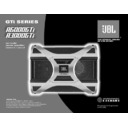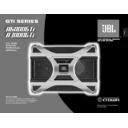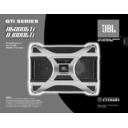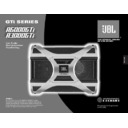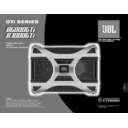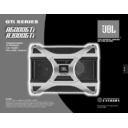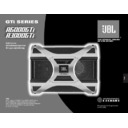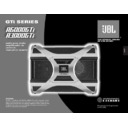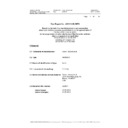JBL A6000GTI (serv.man5) User Manual / Operation Manual ▷ View online
car audio
power amplifier
owner’s manual
power amplifier
owner’s manual
THANK YOU
for purchasing a JBL A6000GTi or A3000GTi amplifier.
For warranty support, please register your purchase at www.jbl.com.
Select Car Audio, then click on Support, and then click on Product Registration.
Also, please retain your original purchase receipt and packing crate
in case you must ship your unit back for service.
for purchasing a JBL A6000GTi or A3000GTi amplifier.
For warranty support, please register your purchase at www.jbl.com.
Select Car Audio, then click on Support, and then click on Product Registration.
Also, please retain your original purchase receipt and packing crate
in case you must ship your unit back for service.
INSTALLATION
WARNING: Playing loud music
in an automobile can hinder your
ability to hear traffic and permanently
damage your hearing. We recommend
listening at low or moderate levels
while driving your car. JBL accepts
no liability for hearing loss, bodily injury
or property damage resulting from the
use or misuse of this product.
in an automobile can hinder your
ability to hear traffic and permanently
damage your hearing. We recommend
listening at low or moderate levels
while driving your car. JBL accepts
no liability for hearing loss, bodily injury
or property damage resulting from the
use or misuse of this product.
IMPORTANT: To get the best
performance from your JBL A6000GTi or
A3000GTi amplifier, we strongly
recommend that installation be entrust-
ed to a qualified professional. Although
these instructions explain how to install
JBL amplifiers in a
general sense, they do not show
specific installation methods that may
be required for your particular vehicle.
If you do not have the necessary tools
or experience, do not attempt the
installation yourself. Instead, please ask
your authorized JBL car audio dealer
about professional installation.
performance from your JBL A6000GTi or
A3000GTi amplifier, we strongly
recommend that installation be entrust-
ed to a qualified professional. Although
these instructions explain how to install
JBL amplifiers in a
general sense, they do not show
specific installation methods that may
be required for your particular vehicle.
If you do not have the necessary tools
or experience, do not attempt the
installation yourself. Instead, please ask
your authorized JBL car audio dealer
about professional installation.
INSTALLATION
WARNINGS AND TIPS
• Always wear protective eyewear
WARNINGS AND TIPS
• Always wear protective eyewear
when using tools.
• Turn off all audio components and
other electrical devices before you
start. Disconnect the (–) negative lead
from your vehicle’s battery.
start. Disconnect the (–) negative lead
from your vehicle’s battery.
• Check clearances on both sides of
a planned mounting surface before
drilling holes or installing screws.
Remember – the screws can extend
behind the surface.
drilling holes or installing screws.
Remember – the screws can extend
behind the surface.
• At the installation sites, locate
and make a note of all fuel lines,
hydraulic brake lines, vacuum lines,
and electrical wiring. Use extreme
caution when cutting or drilling in and
around these areas.
hydraulic brake lines, vacuum lines,
and electrical wiring. Use extreme
caution when cutting or drilling in and
around these areas.
• Before drilling or cutting holes, use
a utility knife to remove unwanted
fabric or vinyl to keep material from
snagging in a drill bit.
fabric or vinyl to keep material from
snagging in a drill bit.
• When routing cables, keep input-
signal cables away from power
cables and speaker wires. Use
grommets when passing cables
through the vehicle’s inner walls.
cables and speaker wires. Use
grommets when passing cables
through the vehicle’s inner walls.
• When making connections, observe
the amplifier’s polarity markings.
Make sure that each connection
is clean and properly secured. Use
the shortest ground wire possible
to minimize resistance and avoid
noise problems.
Make sure that each connection
is clean and properly secured. Use
the shortest ground wire possible
to minimize resistance and avoid
noise problems.
• If the amplifier’s fuse must be
replaced, use only the same type
and rating as that of the original.
Do not substitute another kind.
and rating as that of the original.
Do not substitute another kind.
CHOOSING A
MOUNTING LOCATION
MOUNTING LOCATION
The JBL A6000GTi and A3000GTi
amplifiers are big! Conventional mount-
ing locations under driver or passenger
seats will not accommodate either
amplifier. Mount the amplifier in the
vehicle’s trunk or cargo area, but never
mount the amplifier in the engine com-
partment, outside the vehicle or
in any location where it may get wet.
When choosing a location, make sure
the site’s underlying structure is strong
enough to support the amplifier’s
weight and drilled holes for mounting
bolts. Also, verify that there will be ade-
quate ventilation around the amplifier,
so that airflow to its internal fans will
not be blocked and the unit can
properly cool itself.
amplifiers are big! Conventional mount-
ing locations under driver or passenger
seats will not accommodate either
amplifier. Mount the amplifier in the
vehicle’s trunk or cargo area, but never
mount the amplifier in the engine com-
partment, outside the vehicle or
in any location where it may get wet.
When choosing a location, make sure
the site’s underlying structure is strong
enough to support the amplifier’s
weight and drilled holes for mounting
bolts. Also, verify that there will be ade-
quate ventilation around the amplifier,
so that airflow to its internal fans will
not be blocked and the unit can
properly cool itself.
WARNING: To avoid personal injury and
possible product damage, we strongly
urge you to enlist additional help in
unpacking and moving the
JBL A6000GTi or A3000GTi amplifier
to a desired mounting location.
possible product damage, we strongly
urge you to enlist additional help in
unpacking and moving the
JBL A6000GTi or A3000GTi amplifier
to a desired mounting location.
PARTS LIST
Each amplifier is packed with the fol-
lowing parts:
• Four (4) 1/2" x 3" socket-head cap
lowing parts:
• Four (4) 1/2" x 3" socket-head cap
screws and T-nuts.
• One (1) Remote Level Control with
mounting hardware
• One (1) 15' RJ11 Cable for Remote
Level Control
• One (1) Logo Badge
• One (1) Set of Performance Graphs
• One (1) Owner’s Manual
• One (1) Warranty Registration
Instruction Card
MOUNTING THE
AMPLIFIER
AMPLIFIER
We strongly recommend first mounting
a piece of wood or Medium Density
Fiberboard (MDF) to the vehicle, and
then mounting the amplifier to the
board. The amplifier is large and heavy
and must be mounted using all four
screws and T-nuts provided. Using
the amplifier as a template, mark the
location of the mounting holes on the
mounting surface, drill pilot holes, and
securely attach the amplifier to the
mounting surface with the provided
screws and T-nuts. Make sure the
amplifier does not pinch or smash
power cables, speaker wires, input
cables or any of the vehicle’s wiring.
a piece of wood or Medium Density
Fiberboard (MDF) to the vehicle, and
then mounting the amplifier to the
board. The amplifier is large and heavy
and must be mounted using all four
screws and T-nuts provided. Using
the amplifier as a template, mark the
location of the mounting holes on the
mounting surface, drill pilot holes, and
securely attach the amplifier to the
mounting surface with the provided
screws and T-nuts. Make sure the
amplifier does not pinch or smash
power cables, speaker wires, input
cables or any of the vehicle’s wiring.
Install the Remote Level Control in a
convenient location in or under the
dashboard. The control may be
removed from its housing for custom
installation. Using the enclosed RJ11
cable, connect the control to the
amplifier, as shown in Figure 1.
convenient location in or under the
dashboard. The control may be
removed from its housing for custom
installation. Using the enclosed RJ11
cable, connect the control to the
amplifier, as shown in Figure 1.
2
A6000GTi/A3000GTi
(on input panel)
RJ11 Cable
RJ45 connector
RJ45 connector on back
Figure 1. Connecting the Remote Level
Control.
Control.
Once the amplifier is mounted, peel the
backing from the adhesive (on the back
of the logo badge) and attach the badge
in the appropriate orientation.
backing from the adhesive (on the back
of the logo badge) and attach the badge
in the appropriate orientation.
DESIGNING A SPEAKER SYSTEM FOR THE GTI AMPLIFIER
NOTE: Although the JBL A6000GTi or
A3000GTi amplifier will drive a system
made up of any subwoofers, we
recommend using JBL GTi subwoofers
with GTi amplifiers.
A3000GTi amplifier will drive a system
made up of any subwoofers, we
recommend using JBL GTi subwoofers
with GTi amplifiers.
Both the JBL A6000GTi and A3000GTi
amplifiers provide RMS power that
exceeds the RMS power-handling
rating of nearly every subwoofer
available. To use this amplifier
optimally, you should design a speaker
system made up of several identical
speakers, so that the power delivered
by the amplifier will be shared equally
among the speakers.
amplifiers provide RMS power that
exceeds the RMS power-handling
rating of nearly every subwoofer
available. To use this amplifier
optimally, you should design a speaker
system made up of several identical
speakers, so that the power delivered
by the amplifier will be shared equally
among the speakers.
The JBL A6000GTi and A3000GTi
amplifiers support a wide range of
impedances, and any speaker system
with a total or equivalent impedance of
1 to 4 ohms will extract full power from
either amplifier. In order to connect
multiple woofers to the A6000GTi or
A3000GTi, you’ll need to connect your
speakers in series, parallel or series-
parallel. We’ve included diagrams for
each connection scheme and a pair of
formulas, which will help you.
amplifiers support a wide range of
impedances, and any speaker system
with a total or equivalent impedance of
1 to 4 ohms will extract full power from
either amplifier. In order to connect
multiple woofers to the A6000GTi or
A3000GTi, you’ll need to connect your
speakers in series, parallel or series-
parallel. We’ve included diagrams for
each connection scheme and a pair of
formulas, which will help you.
SERIES CONNECTIONS
The formula for determining the total
impedance of the two woofers connect-
ed in series is:
impedance of the two woofers connect-
ed in series is:
Z
total
= Z
1
+ Z
2
+ Z
3
...
Where Z
total
is the total impedance of
all woofers connected in series. Z
1
, Z
2
and Z
3
(and so on) are the nominal
impedance ratings of the individual
speakers. The total impedance of the
voice coils shown in Figure 2 is 8 ohms.
speakers. The total impedance of the
voice coils shown in Figure 2 is 8 ohms.
Figure 2. Series connection of two
4-ohm voice coils yields a total
impedance of 8 ohms.
4-ohm voice coils yields a total
impedance of 8 ohms.
PARALLEL CONNECTIONS
The formula for determining the
equivalent impedance of the voice coils
connected in parallel is:
equivalent impedance of the voice coils
connected in parallel is:
Z
equivalent
= 1/(1/Z
1
+ 1/Z
2
+ 1/Z
3
…)
Where Z
equivalent
is the equivalent
impedance of the coils connected in
parallel. Z
parallel. Z
1
, Z
2
and Z
3
(and so on) are
the nominal impedance ratings of the
individual speakers. The equivalent
impedance of the voice coils shown in
Figure 3 is 2 ohms.
individual speakers. The equivalent
impedance of the voice coils shown in
Figure 3 is 2 ohms.
Figure 3. Parallel connection of two
4-ohm voice coils yields a total
impedance of 2 ohms.
4-ohm voice coils yields a total
impedance of 2 ohms.
DUAL VOICE-COIL
CONNECTIONS
CONNECTIONS
Dual voice-coil subwoofers, such as
JBL’s GTi series, may be connected
in series, as shown in Figure 2;
in parallel, as shown in Figure 3; or in
series-parallel, as shown in Figure 4.
JBL’s GTi series, may be connected
in series, as shown in Figure 2;
in parallel, as shown in Figure 3; or in
series-parallel, as shown in Figure 4.
Figure 4. Series-parallel connections
of three W15GTi subwoofers (with a
voice coil impedance of 6 ohms) yields
a total series impedance of 12 ohms
for each subwoofer, and an equivalent
parallel impedance of 4 ohms for all
three subwoofers.
of three W15GTi subwoofers (with a
voice coil impedance of 6 ohms) yields
a total series impedance of 12 ohms
for each subwoofer, and an equivalent
parallel impedance of 4 ohms for all
three subwoofers.
To determine the impedance of a
system of three W15GTi (dual voice-
coil) subwoofers connected in series-
parallel, use the series connection
formula to determine the impedance
of each subwoofer with its voice coils
connected in series. Then insert the
calculated value into the parallel
connection formula to determine the
equivalent impedance for the three sub-
woofers connected in parallel.
system of three W15GTi (dual voice-
coil) subwoofers connected in series-
parallel, use the series connection
formula to determine the impedance
of each subwoofer with its voice coils
connected in series. Then insert the
calculated value into the parallel
connection formula to determine the
equivalent impedance for the three sub-
woofers connected in parallel.
NOTE: Each W15GTi voice coil has an
impedance of 6 ohms.
impedance of 6 ohms.
For example, in Figure 4, each woofer
will have an impedance of 12 ohms, by
will have an impedance of 12 ohms, by
Z
total
= Z
1
+ Z
2
= 6 + 6 = 12
and the three woofers connected
in parallel will have an equivalent
impedance of 4 ohms, by
in parallel will have an equivalent
impedance of 4 ohms, by
Z
equivalent
= 1/(1/Z
1
+ 1/Z
2
+ 1/Z
3
)
= 1/(1/12 + 1/12 + 1/12)
= 1/(3/12)
= 12/3 = 4
= 1/(3/12)
= 12/3 = 4
NOTE: All subwoofers connected to an
amplifier in a system must be identical
and, if they are dual voice-coil sub-
woofers, their coils must be wired iden-
tically. Do not connect the coils of one
subwoofer together in series and
another in parallel, since doing so will
cause uneven power distribution,
potential damage to the speakers, and
poor overall performance.
amplifier in a system must be identical
and, if they are dual voice-coil sub-
woofers, their coils must be wired iden-
tically. Do not connect the coils of one
subwoofer together in series and
another in parallel, since doing so will
cause uneven power distribution,
potential damage to the speakers, and
poor overall performance.
ABOUT SPEAKER
POWER HANDLING
POWER HANDLING
The RMS power handling rating of
a speaker indicates the amount of
power it will handle continuously.
Although designing a subwoofer
system by considering the RMS rating
will ultimately provide you with the
most reliable system, your speakers
may be able to handle more power,
depending on what kind of music is
being reproduced.
a speaker indicates the amount of
power it will handle continuously.
Although designing a subwoofer
system by considering the RMS rating
will ultimately provide you with the
most reliable system, your speakers
may be able to handle more power,
depending on what kind of music is
being reproduced.
For music with extended bass notes
(e.g., bass music, hip-hop or techno),
you should design a speaker system
based on the RMS power handling of
your speakers. For music with sharp
transient bass notes (e.g., rock,
country or jazz), the RMS power
handling rating is conservative, and you
can count on your speakers being able
to handle more power than the RMS
rating.
(e.g., bass music, hip-hop or techno),
you should design a speaker system
based on the RMS power handling of
your speakers. For music with sharp
transient bass notes (e.g., rock,
country or jazz), the RMS power
handling rating is conservative, and you
can count on your speakers being able
to handle more power than the RMS
rating.
The total power output of your
amplifier will be divided among the
speakers connected to it. For example,
if you are using an A6000GTi and three
W15GTi subwoofers, each subwoofer
will receive 2,000 watts.
amplifier will be divided among the
speakers connected to it. For example,
if you are using an A6000GTi and three
W15GTi subwoofers, each subwoofer
will receive 2,000 watts.
It’s important to choose a system of
subwoofers that will handle all of the
power. To determine how much total
power your speaker system will
handle, simply multiply the RMS power
handling rating of one of your speakers
by the total number of speakers that
will be connected.
subwoofers that will handle all of the
power. To determine how much total
power your speaker system will
handle, simply multiply the RMS power
handling rating of one of your speakers
by the total number of speakers that
will be connected.
3
4 ohms
4 ohms
Remove
Terminal Jumper
Remove
Terminal Jumper
Black
Red
4 ohms
4 ohms
4
SUPPLYING POWER TO THE GTI AMPLIFIER
POWER IN IS
POWER OUT
POWER OUT
In order to get full power out of your
amplifier, you must provide full power to
your amplifier. That’s a basic rule
of physics. The A6000GTi amplifier
can draw nearly 800 amperes when
reproducing sine waves at full output.
Both JBL A6000GTi and A3000GTi ampli-
fiers can quickly exhaust the
factory-installed charging system of
any vehicle on the road today. With this
much available amplifier power, you will
need to beef up your vehicle’s
electrical system to satisfy the
amplifier’s current demands. We
recommend adding at least two
12-volt batteries, connected in
parallel with cold-cranking capacities
of at least 600 amperes each, to the
factory-installed charging system.
amplifier, you must provide full power to
your amplifier. That’s a basic rule
of physics. The A6000GTi amplifier
can draw nearly 800 amperes when
reproducing sine waves at full output.
Both JBL A6000GTi and A3000GTi ampli-
fiers can quickly exhaust the
factory-installed charging system of
any vehicle on the road today. With this
much available amplifier power, you will
need to beef up your vehicle’s
electrical system to satisfy the
amplifier’s current demands. We
recommend adding at least two
12-volt batteries, connected in
parallel with cold-cranking capacities
of at least 600 amperes each, to the
factory-installed charging system.
HOW YOUR CHARGING
SYSTEM WORKS
SYSTEM WORKS
The battery’s job is to start your
vehicle. Running the electrical
accessories is the alternator’s job.
The battery isn’t designed to be a
continuous source of power. It is a
renewable source and is charged by
the alternator when the engine runs.
Battery charging can only occur when
the current demand from the electrical
accessories is less than the total cur-
rent output capacity of the alternator.
vehicle. Running the electrical
accessories is the alternator’s job.
The battery isn’t designed to be a
continuous source of power. It is a
renewable source and is charged by
the alternator when the engine runs.
Battery charging can only occur when
the current demand from the electrical
accessories is less than the total cur-
rent output capacity of the alternator.
PROGRAM MATERIAL
AND CURRENT DEMAND
AND CURRENT DEMAND
Music is a combination of loud and
soft sounds, with varying durations
and rhythms that present unique
current demands during amplification.
For example, it may take full power
to reproduce the sound of a kick
drum. The peak power demand doesn’t
last very long, but it is repeated over
and over.
soft sounds, with varying durations
and rhythms that present unique
current demands during amplification.
For example, it may take full power
to reproduce the sound of a kick
drum. The peak power demand doesn’t
last very long, but it is repeated over
and over.
If your charging system can’t provide all
the power your amplifier needs on
a continuous basis, it still may be
adequate. During the sound of the
kick drum, the battery can provide
the extra current that’s necessary,
and between kick drum beats, the alter-
nator will put some of the energy back
into the battery.
the power your amplifier needs on
a continuous basis, it still may be
adequate. During the sound of the
kick drum, the battery can provide
the extra current that’s necessary,
and between kick drum beats, the alter-
nator will put some of the energy back
into the battery.
However, depending on the current rat-
ing of the alternator, the amplifier’s
maximum output power, the music
content, and the charging system’s
capability, the alternator may not be
able to keep up over time. In that case,
you’ll need to install a somewhat larger
alternator for more current, or adjust
your driving and listening habits, to give
the alternator time to catch up with the
amplifier’s current demand.
ing of the alternator, the amplifier’s
maximum output power, the music
content, and the charging system’s
capability, the alternator may not be
able to keep up over time. In that case,
you’ll need to install a somewhat larger
alternator for more current, or adjust
your driving and listening habits, to give
the alternator time to catch up with the
amplifier’s current demand.
Few stock batteries can provide the
current required to reproduce even
short-duration musical peaks. Adding
a pair of batteries with cold-cranking
capacities of 600 amperes will provide
extra current for short music bursts, but
reserve power may still be
depleted over longer music intervals.
Adding more batteries will provide more
reserve power and current, but no mat-
ter how many are installed, the alterna-
tor will still have to recharge them all.
current required to reproduce even
short-duration musical peaks. Adding
a pair of batteries with cold-cranking
capacities of 600 amperes will provide
extra current for short music bursts, but
reserve power may still be
depleted over longer music intervals.
Adding more batteries will provide more
reserve power and current, but no mat-
ter how many are installed, the alterna-
tor will still have to recharge them all.
If you plan to use the A6000GTi or
A3000GTi in SPL competition, the charg-
ing system requirements will be much
greater than those for normal music lis-
tening. Be prepared to add additional
batteries and alternators to provide
continuous current required for contin-
uous duty.
A3000GTi in SPL competition, the charg-
ing system requirements will be much
greater than those for normal music lis-
tening. Be prepared to add additional
batteries and alternators to provide
continuous current required for contin-
uous duty.
See your authorized JBL car audio
dealer for help in designing and
installing an upgraded charging
system to support your GTi amplifier.
dealer for help in designing and
installing an upgraded charging
system to support your GTi amplifier.

